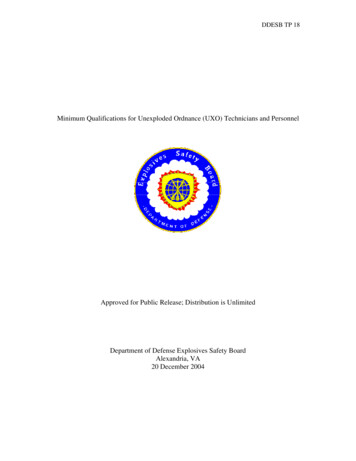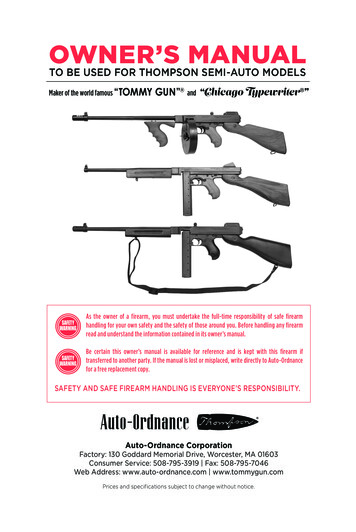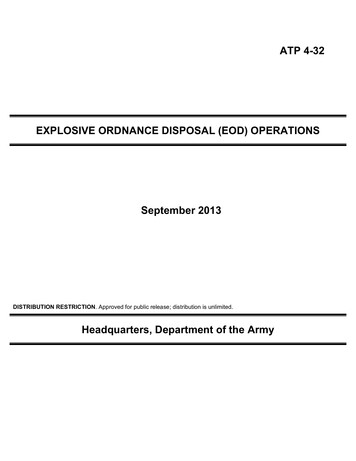
Transcription
DDESB TP 18Minimum Qualifications for Unexploded Ordnance (UXO) Technicians and PersonnelApproved for Public Release; Distribution is UnlimitedDepartment of Defense Explosives Safety BoardAlexandria, VA20 December 2004
DDESB TP 18TABLE OF CONTENTSFOREWORD2TABLE OF CONTENTS3TABLE4REFERENCE4ACRONYMS5C1. INTRODUCTIONC1.1. GENERALC1.2. APPLICABILITYC1.3 KEEPING TECHNICAL PAPER 18 CURRENT7777C2. UXO-RELATED POSITION TITLES AND TASKSC2.1. DUTIES AND RESPONSIBILITIES88C3. UXOTI TRAINING STANDARDSC3.1. MINIMUM TRAINING STANDARDS FOR UXOTIC3.2. CURRICULUM AND TRAINING OBJECTIVES121212C4. MINIMUM QUALIFICATION STANDARDSC4.1. MINIMUM QUALIFICATION STANDARDS2121APPENDIX AP1. DEFINITIONS243
DDESB TP 18TABLETable 4-1. Minimum Qualifications Standards .22REFERENCEReport of the Integrated Product Team (IPT) for Unexploded Ordnance (UXO) Remediation –Personnel Qualification Standards, October 20004
DDESB TP 18ACRONYMSCCACWMCapacitanceChemical AgentChemical Warfare MaterialDCDDESBDoDDMMDirect CurrentDepartment of Defense Explosives Safety BoardDepartment of DefenseDiscarded Military MunitionsEMFEODElectro-Motive ForceExplosive Ordnance DisposalHAZWOPERHEROHazardous Waste Operations and Emergency ResponseHazards of Electromagnetic Radiation to OrdnanceIPTIntegrated Product TeamMCMECMPPEHMRAMRSMunitions ConstituentsMunitions and Explosives of ConcernMaterial Potentially Presenting an Explosive HazardMunitions Response AreaMunitions Response SiteNAVSCOLEODNaval School, Explosive Ordnance DisposalPPEPersonal Protective EquipmentQCPPQuality Control Program PlanRSPRender Safe ProceduresSUXOSSenior UXO SupervisorTEUTPTechnical Escort UnitTechnical PaperU.S.UXOUXOQCSUXOSOUXOSPUnited StatesUnexploded OrdnanceUXO Quality Control SpecialistUXO Safety OfficerUXO Sweep Personnel5
DDESB TP 18UXOTIUXOTIIUXOTIIIUXO Technician IUXO Technician IIUXO Technician III6
DDESB TP 18C1. CHAPTER 1INTRODUCTIONC1.1. GENERALC1.1.1. This document provides minimum qualification standards for personnelperforming unexploded ordnance (UXO)-related operations in support of the Department ofDefense with the exception of DoD Explosives Ordnance Disposal (EOD) personnel. Suchoperations include, but may not be limited to: military munitions responses, range clearanceactivities, range maintenance, and inspection or certification of munitions debris and rangerelated debris being considered for transfer or release from DoD control.C1.1.2. Personnel performing or supervising UXO-related activities shall meet theminimum qualification standards commensurate with their duties.C1.2. APPLICABILITYThe requirements herein apply to all workers performing Department of Defense operationsrequiring UXO Technicians or UXO-qualified personnel.C1.3 KEEPING TECHNICAL PAPER(TP) 18 CURRENTThis technical paper will be updated as needed based on input from the DoD Components.7
DDESB TP 18C2. CHAPTER 2UXO-RELATED POSITION TITLES AND TASKSC2.1. DUTIES AND RESPONSIBILITIESThis chapter identifies the various UXO-related positions by title and outlines their duties andresponsibilities. Training levels should be documented and retained for personnel involved inUXO related operations. Divers conducting underwater detection and identification of munitionsmust have completed both the basic and the underwater portions of NAVSCOLEOD (or foreignequivalent) training.C2.1.1. UXO-Sweep Personnel (UXOSP). UXOSP assist UXO technicians and UXOqualified personnel in the performance of UXO-related operations. UXOSP do not have to be aUXO technician, however, they shall be provided job and site specific training. Such trainingshall, at a minimum include training in: explosives safety; recognition of munitions andexplosives of concern (MEC), particularly UXO; and the proper use of personal protectiveequipment (PPE). UXOSP are not involved in the execution of explosives operations and shallnot have intentional physical contact with MEC. With direction and supervision of UXOqualified personnel, UXOSP may:C2.1.1.1. Conduct visual and/or detector-aided UXO and discarded militarymunitions (DMM) field search activities.C2.1.1.2. Locate subsurface UXO and DMM by operating geophysical detectioninstruments and related equipment.C2.1.1.3. Perform field maintenance and calibration checks on geophysicaldetection instruments and related equipment.C2.1.1.4. Remove non-hazardous munitions debris and range-related debris, onlyafter such items have been inspected by a UXO technician or UXO qualified personnel anddetermined to be safe for handling.C2.1.1.5. Perform site/area security functions.C2.1.2. UXO Technician I (UXOT1). In addition to being able to fully perform all ofthe UXOSP functions above, and with direction and supervision from UXO-qualified personnel,UXOT1 personnel may:C2.1.2.1. Reconnoiter and classify UXO and DMM.C2.1.2.2. Identify all types of military munitions, including possible fuzes and their8
DDESB TP 18condition, armed or unarmed. Examples of these military munitions are: BombsGuided missilesProjectilesRocketsLand mines and associated componentsPyrotechnic itemsMilitary explosives and demolition materialsGrenadesSubmunitionsC2.1.2.3. Excavate subsurface UXO and DMM.C2.1.2.4 Move and/or consolidate UXO and DMM that has been determinedacceptable for movement within a Munitions Response Site (MRS) or Munitions Response Area(MRA), but not over public traffic routes.C2.1.2.5. Transport demolition materials and/or UXO and DMM that havebeen determined safe for transport over public traffic routes, when required.C2.1.2.6. Prepare firing systems, both electric and non-electric, for demilitarizationoperations.C2.1.2.7. Operate personnel decontamination stations.C2.1.2.8. Assist in the inspection of Material Potentially Presenting an ExplosiveHazard (MPPEH) for the presence of explosive hazards.C2.1.2.9. Construct UXO-related protective works.C2.1.3. UXO Technician II (UXOTII). In addition to being able to fully perform all ofthe UXOSP and UXOT1 functions above, UXOTII personnel may:C2.1.3.1. Properly store explosive materials per applicable guidance.C2.1.3.2. Determine precise location in field environment using a variety oftechniques such as use of global positioning equipment, or basic land navigation techniquesusing topographical map and compass.C2.1.3.3. Perform field collection procedures to identify contaminated soilC2.1.3.4. Prepare an on-site holding area to temporarily stow MEC that has anacceptable risk of movement.9
DDESB TP 18C2.1.3.5. Operate modes of transportation for transporting UXO, for which the riskof movement has been determined acceptable, when appropriate.C2.1.3.6 Perform limited technical supervision of UXOSP.C2.1.3.7. Escort personnel who are not directly involved in UXO-relatedoperations (e.g., personnel performing environmental monitoring), but have activities to performwithin exclusion areas.C2.1.3.8. Inspect MPPEH for the presence of explosives safety hazards.C2.1.4. UXO Technician III (UXOTIII). In addition to being able to fully perform all ofthe UXOSP and for UXOTI and UXOTII functions above, UXOTIII personnel may:C2.1.4.1. Supervise and perform the on-site demilitarization of MEC, and handlingof demolition materials.C2.1.4.2. Prepare an explosives storage plan per all applicable guidance.C2.1.4.3. Prepare required UXO munitions response actions and/or rangemaintenance administrative reports.C2.1.4.4. Prepare standard operating procedures for on-site munitions responsesand/or for range clearance activities.C2.1.4.5. Assist in the preparation of risk and hazards analyses.C2.1.4.6. Conduct daily site safety briefings.C2.1.4.7. Supervise the conduct of all on-site UXO-related operations.C2.1.4.8. Inspect and certify and/or verify MPPEH as safe or as to the explosivehazard it may present for transfer within the Department of Defense or release from DoD controlper current policies and standards.C2.1.5. UXO Quality Control Specialist (UXOQCS). In additional to being able to fullyperform all of the UXOSP, UXOT1, UXOTII, and UXOTIII functions above, UXOQCS may:C2.1.5.1. Develop and implement the MEC-specific sections of the Quality ControlProgram Plan (QCPP) for all explosive related operations.C2.1.5.2. Conduct and document quality control audits of all explosive operationsfor compliance with established procedures.C2.1.5.3. Identify, document, report and ensure completion of all corrective actionsto ensure all explosive operations comply with requirements.10
DDESB TP 18C2.1.6. UXO Safety Officer (UXOSO). In addition to being able to fully perform all ofthe UXOSP, UXOT1, UXOTII, and UXOTIII functions above, UXOSO may:C2.1.6.1. Develop and implement approved explosives and UXO health and safetyprogram in compliance with applicable DoD policy and federal, state, and local health and safetystatutes, regulations and codes.C2.1.6.2. Analyze operational risks, explosive hazards and safety requirements.C2.1.6.3. Establish and ensure compliance with all site-specific explosiveoperations safety requirements.C2.1.6.4. Enforce personnel limits and safety exclusion zones for explosivesrelated operations.C2.1.6.5. Conduct, document, and report the results of safety inspections to ensurecompliance with all applicable explosives safety policies, standards, regulations and codes.C2.1.6.6. Operate and maintain air-monitoring equipment required at sites knownor suspected for airborne contaminates.C2.1.6.7. Ensure all protective works and equipment used within the exclusionzone are operated in compliance with applicable DoD policy, Department of Defense ExplosivesSafety Board (DDESB) approvals, and Federal, state, and local health and safety statutes,regulations and codes.C2.1.7. Senior UXO Supervisor (SUXOS). In addition to being able to fully perform allof the UXOSP, UXOT1, UXOTII, and UXOTIII functions above, SUXOS shall:C2.1.7.1. Plan, coordinate, and supervise all explosives operations.C2.1.7.2. Supervise multiple teams.C2.1.7.3. Assist in development of munitions response plans.11
DDESB TP 18C3. Chapter 3UXOT1 TRAINING STANDARDSC3.1. MINIMUM TRAINING STANDARDS FOR UXOTIThis chapter contains the minimum training standards for entry-level personnel to fill UXOTIpositions on projects under DoD contracts. The training consists of both knowledge and skillsrequirements, and candidates must demonstrate the requisite knowledge of explosive operationsand the ability to perform required tasks in compliance with existing operational and safetyguidelines.C3.1.1. Each candidate for a UXO Technician I position shall have completed: 200 hours of training on MEC and MPPEH40 hours of Hazardous Waste Operations and Emergency Response(HAZWOPER) trainingC3.1.2. This training shall be provided by an institution of higher education that shallcertify successful completion of all requirements through written exams and practical exercises.Such institutes shall be accredited by a nationally recognized college or university educationalaccrediting agency, or a training institute authorized by either the Federal or a State governmentto provide certified training in the public service sector and shall have a demonstrated history ofproviding quality training programs.C3.1.3. The employer shall certify that the individuals are qualified, as demonstrated bysuccessful completion of the requisite training.C3.2. CURRICULUM AND TRAINING OBJECTIVESC.3.2.1. Range Clearance Activities.C.3.2.1.1. Description. Understand range clearance requirements and proceduresincluding safety and environmental concerns.C.3.2.1.2. Objectives. Describe the purpose for clearing and maintaining ranges and impactareasDescribe planning, safety, and environmental requirements for rangeclearance activitiesC.3.2.2. Measurements and Mathematical Computations.12
DDESB TP 18C.3.2.2.1. Description. Understand U.S. and metric conversion methods and basicmathematical computations.C.3.2.2.2. Objectives. Identify metric prefixesDescribe mathematical conversions within the metric systemConvert from U.S. to metric and metric to U.S.C.3.2.3. Electricity.C.3.2.3.1. Description. Knowledge of basic electricity and circuits .C.3.2.3.2. Objectives. Define terms and identify abbreviations and symbolsDescribe electrical conductivity and its characteristics in differentmaterialsDescribe types of cells and batteries, their construction features,and process used to generate electro-motive force (EMF)Describe current flow, factors that affect current flow (includingswitches) and units of measurement of current flow.Describe electrical resistance and the factors that affect resistanceDescribe the operation of a series direct current (DC) circuit withrespect to Ohms LawDescribe the operation of basic parallel DC circuits with respect tothe determination of equivalent resistanceDescribe capacitance (C) in terms of charging and discharging acapacitorC.3.2.4 . Physics.C.3.2.4.1. Description. Understanding of basic physics.C.3.2.4.2. Objectives. Define terms and identify abbreviations and symbolsDescribe forces and how they are graphically representedDescribe Newton's first and third laws of motionDescribe the difference between weight and massDescribe hydrostatics with respect to fluid pressureDescribe properties of matterDefine motion, work, and energyDescribe measures of and forces affecting motionDefine work and energy13
DDESB TP 18 Identify the physical laws affecting gasesDefine magnetismC.3.2.5. Explosives and Explosive Effects.C.3.2.5.1. Description. Basic understanding of explosives and explosive effects.C.3.2.5.2. Objectives. Define terms and identify abbreviations and symbolsSummarize the history of explosivesDefine explosives, propellants, and pyrotechnicsDescribe characteristics of military high explosives, propellants,and pyrotechnicsIdentify the types of high explosive groupsIdentify forms and classes of propellants, black powder,pyrotechnic and tracer compositionsDefine explosive trainDefine explosion and identify types of explosionsDescribe forms of energy produced by explosionsDescribe types of explosions (detonations, partial detonations,deflagrations)Describe effects of an explosion (air blast, fragments, debris,thermal, ground shock)C.3.2.6. Military Fuze Functioning.C.3.2.6.1. Description. Understanding of how military fuzes function.C.3.2.6.2. Objectives. Define terms and identify abbreviationsDescribe fuze forcesDescribe fundamental principles of fuzes, fuze arming and firingprinciplesDescribe fuze componentsDescribe methods of employment and uses of fuzesDescribe typical arming/functioning of fuzesDescribe fuze typesC.3.2.7. Munitions and Explosives of Concern (MEC) and Explosives SafetyPrecautions.14
DDESB TP 18C.3.2.7.1. Description. Understanding of MEC, MPPEH and explosives safetyprecautions.C.3.2.7.2. Objectives. Define terms and identify abbreviations and symbolsDescribe the purpose of munitions and explosives safety precautions.Describe safety considerations that apply by category and group ofMEC and MPPEHDescribe basic safety precautions for the following:explosive-loaded munitions and submunitionstoxic chemical-loaded munitionspyrotechnic and incendiary munitionssmoke-loaded munitionsfuzing systemstraining and practice munitionsunderwater munitions C.3.2.8. Surface Munitions Identification.C.3.2.8.1. Description. Understanding of surface munitions by category andgroup to include: Projectile and projectile bulletsLand mines and associated componentsPyrotechnic itemsRockets and rocket fuzesGrenade and grenade fuzesSubmunitionsC.3.2.8.2. Objectives. Define terms and identify abbreviations and symbolsIdentify "category," "group" and "safety precautions"Demonstrate comprehension and detailed knowledge of live andpractice munitions by category and groupRecognize munitions color codes and markingsDescribe the basic safety precautions for explosive initiatingcomponentsDescribe the safety precautions for surface munitionsC.3.2.9. Air Ordnance Identification (dropped or launched).C.3.2.9.1. Description. Understanding of air munitions by category and group toinclude:15
DDESB TP 18 Bombs and bomb fuzesGuided missiles and missile fuzesRockets and rocket fuzesPyrotechnic itemsSubmunitionsC.3.2.9.2. Objectives. Define terms and identify abbreviations and symbolsIdentify "category," "group" and "safety precautions"Demonstrate comprehension and detailed knowledge of live andpractice munitions by category and groupRecognize munitions color codes and markingsDescribe the basic safety precautions for explosive initiatingcomponentsDescribe the safety precautions for air ordnanceC.3.2.10. Chemical Munitions Identification (Chemical Munitions and ChemicalWarfare Material (CWM)).C.3.2.10.1. Description. Understanding of chemical munitions and CWM toinclude air and surface groups.C.3.2.10.2. Objectives. Define terms and identify abbreviations and symbolsIdentify "category," "group" and "safety precautions"Demonstrate comprehension and detailed knowledge of live andpractice chemical munitions and CWM by category and groupRecognize munitions color codes and markingsDescribe the basic safety precautions for explosive initiatingcomponentsDescribe the safety precautions for chemical munitions and CWMIdentify the effects of weather conditions on the duration ofeffectiveness of chemical agentsIdentify specific chemical agents by physical and chemicalproperties, and physiological effectsC.3.2.11. Pyrotechnic Munitions Identification.C.3.2.11.1. Description. Understanding of pyrotechnic munitions.C.3.2.11.2. Objectives.16
DDESB TP 18 Define terms and identify abbreviations and symbolsIdentify "category," "group" and "safety precautions"Demonstrate comprehension and detailed knowledge of live andpractice pyrotechnic munitions by category and groupRecognize munitions color codes and markingsDescribe the basic safety precautions for explosive initiatingcomponentsDescribe the safety precautions for pyrotechnic munitionsC.3.2.12. Underwater Munitions Identification.C.3.2.12.1. Description. Understanding of underwater munitions.C.3.2.12.2. Objectives. Define terms and identify abbreviations and symbolsIdentify "category," "group" and "safety precautions"Demonstrate comprehension and detailed knowledge of live andpractice underwater munitions by category and groupRecognize munitions color codes and markingsDescribe the basic safety precautions for explosive initiatingcomponentsDescribe the safety precautions for underwater munitionsC.3.2.13. Detection Equipment.C.3.2.13.1. Description. General, physical, functional, operational andmaintenance description of munitions detection equipment for: Location of subsurface MEC using magnetometers (and relatedequipment)Performing evaluation procedures on subsurface MECC.3.2.13.2. Objectives. Describe the purpose of munitions detection equipment;operational characteristics and capabilitiesDescribe the theory of operationDescribe all major and associated components including displays,controls and indicatorsDescribe operational tasks and preventive maintenance proceduresUnderstand how to inventory and maintain equipmentC3.2.14. Munitions Response Planning.17
DDESB TP 18C3.2.14.1. Description. Understanding of the elements of munitionsresponse actions planning.C3.2.14.2. Objectives. Describe the purpose for munitions responsesDescribe planning requirements for munitions responsesDescribe the inspection, verification and certification and chain ofcustody processDescribe the proper assembly of protective worksC3.2.15. Personal Protective Equipment.C3.2.15.1. Description. Understanding of all relevant personal protectiveequipment.C3.2.15.2. Objectives. Understand the capabilities and limitations of PPEUnderstand the requirements for employing PPE safetyDescribe the requirements and process for performingdecontaminationC3.2.16. Demolition Materials.C3.2.16.1. Description. Understanding of demolition materials to include: Military and commercial explosives (U.S. and foreign)Initiating components and systemsC3.2.16.2. Objectives. Define terms and identify abbreviations and symbolsPreparation of firing systems (both electric and non-electric) fordemilitarization operationsDescribe military explosives, commercial explosives, and demolitionmaterials.Describe the purpose of demolition materials and specialized explosivetechniquesDescribe tools and equipment used during demolition operationsDescribe demolition accessoriesDescribe electric power sources and test sets used with demolitionfiring circuitsDescribe demolition charge initiatorsDescribe demolition charges, charge kits and assemblies18
DDESB TP 18 Describe safety precautions for preparation and firing of demolitionmaterialsC3.2.17. Firing Systems.C3.2.17.1. Description. Understanding of firing systems.C3.2.17.2. Objectives. Describe detonating cord demolition proceduresDescribe non-electric firing systemsDescribe electric firing systemsDescribe safety precautions for preparation and firing of demolitionmaterials, including Hazards of Electromagnetic Radiation toOrdnance (HERO) precautions for electric initiatorsC3.2.18. Demilitarization Procedures.C3.2.18.1. Description. Understanding of demilitarization requirements andprocedures for conventional munitions.C3.2.18.2. Objectives. Describe the requirements for and purpose for demilitarization ofconventional munitionsDescribe demilitarization proceduresDescribe the authorized demilitarization methods for different types ofmunitionsDescribe requirements and safety precautions for demilitarizationoperationsDescribe demilitarization of conventional explosives and relatedhazardous materialsC3.2.19. Storage, Handling and Transportation of Explosives (Military andCommercial).C3.2.19.1. Description. Understanding of storage, handling and transportation ofexplosives.C3.2.19.2. Objectives. Describe the purpose for proper storage, handling, and transportationof explosivesDescribe the hazard classification systemDiscuss Storage Compatibility GroupsDiscuss safety requirements19
DDESB TP 18 Discuss transportation requirements for munitions and commercialexplosivesC3.2.20. Skills Requirements.C.3.2.20.1. Description. Demonstrate knowledge of policies, requirements andprocedures in the safe performance of MEC and MPPEH duties.C.3.2.20.2. Objectives. Practical demonstration of knowledge and comprehension ofpolicies and procedures in safely performing the following:Operation of detection equipment.Location and identification of munitions by category andgroup.Designing and constructing firing systems (both electricand non-electric)Design, construct, and detonate a demolition explosive.20
DDESB TP 18C4. CHAPTER 4MINIMUM QUALIFICATION STANDARDSC4.1. MINIMUM QUALIFICATION STANDARDSMinimum qualification standards for workers to qualify as UXO technicians or UXO qualifiedpersonnel are contained in Table 4-1.21
DDESB TP 18Table 4-1. Minimum Qualification StandardsPosition DescriptionSenior UXOSupervisorUXO Safety OfficerUXO QualityControl SpecialistTrainingRequired(Notes 1, 2,& 3)1, 2, or 31, 2, or 31, 2,3Minimum Years ofEOD/UXOExperience(Note 4)10 years8 years8 years1, 2 or 38 years1 or 2N/A------or-----3-------or-----3 yearsUXO Technician I30UXO-SweepPersonnelEquipmentand sitespecifictrainingUXO Technician IIIUXO Technician IISpecial Requirements(Note 5)Significant experience in all aspects ofmunitions response actions or rangeclearance activities, as appropriate for thecontracted operation. Five years experiencein supervisory positions.Experience in all phases of munitionsresponse actions or range clearanceactivities, as appropriate for the contractedoperation, and applicable safety standards.Experience in all phases of munitionsresponse actions or range clearanceactivities, as appropriate for the contractedoperation, and the transportation, handlingand storage of munitions and commercialexplosives.Prior military EOD and/or commercial UXOexperience in munitions response actions orrange clearance activities, as appropriate forthe contracted operation.Prior military EOD -------------Experience in response munitions responseactions or range clearance activities, asappropriate for the contracted operation, plusspecific project/explosives safety training.Successfully completed formal course ofinstruction appropriate to this skill levelSafety Equipment and site specific training.(Experience at this position is not requiredfor UXO Technician I certification.)N/A22
DDESB TP 18Note: 1. Graduate of a military EOD School of the United States.2. Graduate of a military EOD school of Canada, Great Britain, Germany,or Australia.3. Graduate of a formal training course of instruction (see chapter 3 fordetailed requirements) or EOD assistant courses.4. Personnel working in the commercial industry may have significantbreaks between jobs. Only actual time performing UXO-related tasksshould be counted. (2080 hours 1 man-year)5. Divers conducting underwater detection and identification of munitionsmust have completed both the basic and the underwater portions ofNAVSCOLEOD (or foreign equivalent) training.23
DDESB TP 18AP1. DEFINITIONSDiscarded Military Munitions.Military munitions that have been abandoned without proper disposal or removed from storagein a military magazine or other storage area for the purpose of disposal. The term does notinclude unexploded ordnance, military munitions that are being held for future use or planneddisposal, or military munitions that have been properly disposed of consistent with applicableenvironmental laws and regulations. (10 U.S.C. 2710(e)(2))Explosive HazardA condition where danger exists because explosives are present that may react (e.g., detonate,deflagrate) in a mishap with potential unacceptable effects (e.g., death, injury, damage) topeople, property, operational capability or the environment.Explosive Ordnance Disposal (EOD).The detection, identification, on-site evaluation, rendering safe, recovery, and final disposal ofunexploded explosive ordnance. It may also include explosive ordnance, which has becomehazardous by damage or deterioration.Explosive Ordnance Disposal (EOD) Personnel.Military personnel who have graduated from the Naval School, Explosive Ordnance Disposal(NAVSCOLEOD); are assigned to a military unit with a Service-defined EOD mission; and meetService and assigned unit requirements to perform EOD duties. EOD personnel have receivedspecialized training to address explosive and certain Chemical Agent (CA) hazards during bothpeacetime and wartime. EOD personnel are trained and equipped to perform Render SafeProcedures (RSP) on nuclear, biological, chemical, and conventional munitions, and onimprovised explosive devices.Material Potentially Presenting an Explosive Hazard (MPPEH).Material potentially containing explosives or munitions (e.g., munitions containers andpackaging material; munitions debris remaining after munitions use, demilitarization, ordisposal; and range-related debris); or material potentially containing a high enoughconcentration of explosives such that the material presents an explosive hazard (e.g.,equipment, drainage systems, holding tanks, piping, or ventilation ducts that were associatedwith munitions production, demilitarization or disposal operations). Excluded from MPPEH aremunitions within DoD's established munitions management system and other hazardous itemsthat may present explosion hazards (e.g., gasoline cans, compressed gas cylinders) that are notmunitions and are not intended for use as munitions.Military Munitions.All ammunition products and components produced for or used by the armed forces for nationaldefense and security, including ammunition products or components under the control of theDepartment of Defense, the Coast Guard, the Department of Energy, and the National Guard.The term includes confined gaseous, liquid, and solid propellants, explosives, pyrotechnics,24
DDESB TP 18chemical and riot control agents, smokes, and incendiaries, including bulk explosives andchemical warfare agents, chemical munitions, rockets, guided and ballistic missiles, bombs,warheads, mortar rounds, artillery ammunition, small arms ammunition, grenades, mines,torpedoes, depth charges, cluster munitions and dispensers, demolition charges, and devices andcomponents thereof.The term does not include wholly inert items, improvised explosives devices and nuclearweapons, nuclear devices, and nuclear components, except that the term does include nonnuclear components of nuclear devices that are managed under the nuclear weapons program ofthe Department of Energy after all required sanitization operations under the Atomic Energy Actof 1954 (42 U.S.C. 2011 et seq.) have been completed. (See 10 U.S.C. § 2710(e) (3)).Munitions and Explosives of Concern (MEC)This term, which distinguishes specific categories of military munitions that may pose uniqueexplosives safety risks means: (A) Unexploded Ordnance (UXO), as defined in 10 U.S.C.101(e)(5)(A) through (C): (B) Discarded military munitions (DMM), as defined in 10 U.S.C.2710(e)(2): or (C) munitions constituents (e.g., TNT, RDX) present in high enoughconcentrations to pose an explosive hazard.Munitions Constituents (MC).Any materials originating from unexploded ordnance, discarded military munitions, or othermilitary munitions, including explosive and non-explosive materials, and emission, degradation,or breakdown elements of such ordnance or munitions. (10 U.S.C. 2710)Munitions DebrisRemnants of munitions (e.g., fragments, penetrators, projectiles, shell casings, links, fins)remaining after munitions use, demilitarization or disposal.Munitions ResponseResponse actions, including investigation, removal actions and remedial actions to address theexplosives safety, human health, or environmental risks presented by
Alexandria, VA 20 December 2004 . DDESB TP 18 TABLE OF CONTENTS FOREWORD 2 TABLE OF CONTENTS 3 TABLE 4 REFERENCE 4 ACRONYMS 5 C1. INTRODUCTION 7 C1.1. GENERAL 7 . This document provides minimum qualification standards for personnel performing unexploded ordnance (UXO)-related opera tions in support of the Department of .










